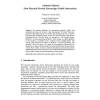Free Online Productivity Tools
i2Speak
i2Symbol
i2OCR
iTex2Img
iWeb2Print
iWeb2Shot
i2Type
iPdf2Split
iPdf2Merge
i2Bopomofo
i2Arabic
i2Style
i2Image
i2PDF
iLatex2Rtf
Sci2ools
PERSUASIVE
2010
Springer
2010
Springer
Animate Objects: How Physical Motion Encourages Public Interaction
The primary challenge for information terminals, kiosks, and incidental use systems of all sorts, is that of getting the “first click” from busy passersby. This paper presents two studies that investigate the role of motion and physicality in drawing people to look and actively interact with generic information kiosks. The first study was designed as a 2x2 factorial design, physical v. on-screen gesturing and hand v. arrow motion, on a kiosk deployed in two locations, a bookstore and a computer science building lobby. The second study examined the effect of physical v. projected gesturing, and included a follow-up survey. Over twice as many passersby interacted in the physical v. on-screen condition in the first study and 60% more interacted in the second. These studies, in concert, indicate that physical gesturing does indeed significantly attract more looks and use for the information kiosk, and that form affects people’s impression and interpretation of these gestures.
| Added | 29 Jan 2011 |
| Updated | 29 Jan 2011 |
| Type | Journal |
| Year | 2010 |
| Where | PERSUASIVE |
| Authors | Wendy Ju, David Sirkin |
Comments (0)

